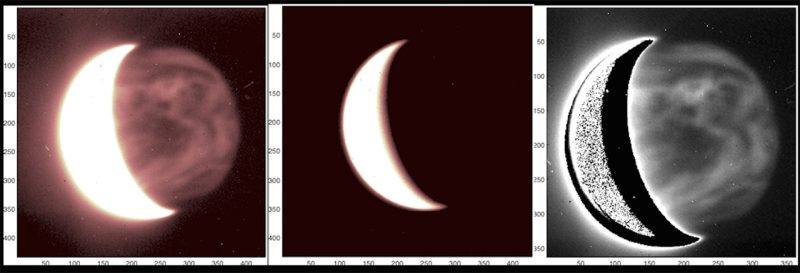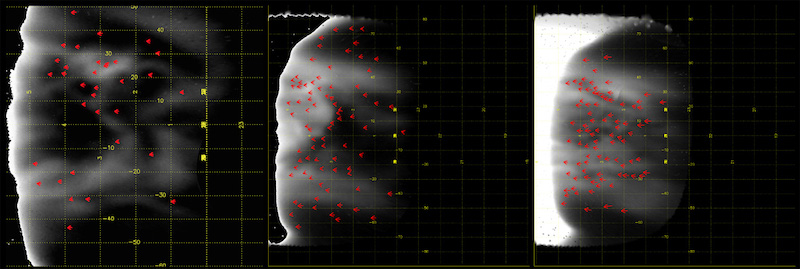
Researchers said in late February, 2022, that they’ve completed the most detailed profile yet of Venus’ nightside winds. They describe the connection of these winds to the greenhouse effect that keeps the planet hot enough on its surface to melt lead. Venus is completely covered by thick clouds, and – especially on the planet’s nightside – these winds are strong. They blow to the west, both above and below the planet’s enshrouding cloud deck, parallel to the equator.
The researchers were led by Pedro Machado at the Institute of Astrophysics and Space Sciences in Portugal. The peer-reviewed journal Atmosphere published their findings on February 17, 2022.
The 2022 lunar calendars are still available. Order yours before they’re gone!

As above, so below?
The new measurements are the most detailed ever made from an Earth-based observatory, Telescopio Nazionale Galileo (TNG) in La Palma, Canary Islands. The researchers wanted to study the winds on the nightside of Venus, which blow parallel to the equator (also known as zonal winds). A phenomenon called super-rotation produces these perpetual winds. On Venus, the atmosphere circles the planet in just over four Earth days. That’s 60 times faster than the rotation period of the planet itself, which takes 243 Earth days. At the altitude of these winds, about 43 miles (70 km), the normal wind speed is around 224 miles per hour (360 kph).
In this study, the researchers measured wind speeds at two different heights, both above and below the cloud deck. About 12 miles (20 km) in altitude separate those wind zones. That relatively small distance makes a big difference, however. Winds at the top of the clouds are about 93 miles per hour (150 kph) faster than those at the bottom of the clouds.
Nightside winds and the runaway greenhouse effect
The difference in wind speeds provides clues as to how heat moves upward in Venus’ atmosphere. That heat then feeds the super-rotation effect. Machado explained:
Winds accelerate as we move upward to increasing altitudes, but we don’t know yet why. This study throws much light on this, because we managed to study the vertical variation of the westward winds, to help us understand the role of the solar tides and other waves in feeding this mysterious super-rotation.

As we know, hot air tends to rise while cold air sinks. This applies to Venus as well. Due to the carbon dioxide’s contribution to the greenhouse effect, the temperature at the surface is a sweltering 860 degrees Fahrenheit (460 C). The heated air then moves upward. The heat produces infrared radiation, which passes through the bottom of the cloud deck at about 30 miles (48 km) altitude. That radiation is visible when you view Venus through infrared telescopes.
Calculating speed of nightside winds
Coauthor Javier Peralta at the University of Seville improved a tracking technique to measure the wind speeds in Venus’ atmosphere. The measurements showed that at the bottom of the cloud deck, the speed is about 134 miles per hour (216 kph). It then decreases by about half closer to the planet’s poles.
The researchers used TNG’s infrared images from July 11 to 13, 2012. The images covered the planet almost from pole to pole on the planet’s nightside.
As it happened, ESA’s Venus Express orbiter was also taking ultraviolet images at the same time. Those images focused on the tops of the clouds at about 43 miles (70 km) altitude. Here, the winds were faster, clocking in at 224 miles per hour (360 kph).
In addition, the researchers found that wind speeds at the bottom of the cloud deck remain almost constant. This was true whether it was day or night. Also, the wind speed at night is the same as that lower down in the atmosphere during the day.
This was the first time instruments measured the wind speeds at two different latitudes at the same time. Basically, the speed of wind parallel to the equator is 93 miles per hour (150 kph) faster on the dayside of Venus.

Future observations
Now, the researchers want to continue monitoring Venus’ wind speeds using the Japanese Akatsuki probe, which is currently orbiting the planet. These observations could further complement ones made by ground-based telescopes.
Another upcoming ESA mission, EnVision, will focus more on studying Venus’ geology, both surface and subsurface. However, the improved knowledge of Venus’ atmosphere will help scientists decide which wavelengths of light (on the electromagnetic spectrum) will be the best to use. Machado said:
This work shows the kind of science that will be enabled with the EnVision instruments. We are already demonstrating the great relevance of the science that will be possible with this future mission.
Bottom line: Scientists have made the most detailed observations of Venus’ equatorial nightside winds, which are connected to the planet’s runaway greenhouse effect.











